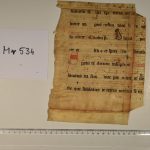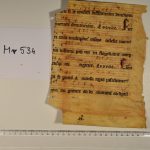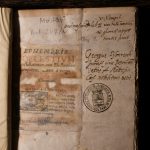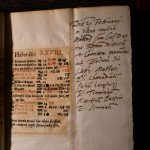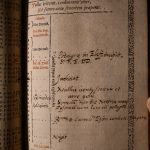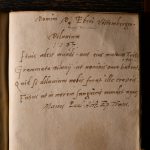According to the library’s documentation the host volume was restored in 2017, it got its modern leather binding at that time. The parchment leaf once covering the book was probably detached much earlier and stored in a separate box amongst other detached fragments. The ‘Momentum’ Digital Music Fragmentology Research Group identified the fragment detached from its host volume in December of 2022 thus joining it virtually with its quondam carrier.
The diary-like notes of Zakariás Mossóczy, royal councillor and bishop of Knin, Nyitra and Vác are legible in the calendars of the composite volume with dates, personal names and geographical locations, references to historical events, to the personal and family life of Mossóczy, also occasionally to his health (among others the gout he suffered from). The entry on the title-page of the first book attests that the Pozsony (Bratislava in present-day Slovakia) citizen, György Eisenreich received the patent of nobility (Gerogius Eisenreich, juratus civis Posoniensis Veteris a Maiestate sua Caesarea nobilitati petit). It is possible that György Eisenreich is identic to the person, who was referred to as a juror in the charter reconfirming the regulae of the weaver’s guild in Pozsony from the 5th of June, 1579 (comp. „Céhbeli szabályok” [Guild rules], published by Károly Ráth, in Győri Történelmi és Régészeti Füzetek vol. I, ed. Károly Ráth – Flóris Rómer, Győr, 1861, 50–56). There are notes referring to the investiture of Mossóczy as the bishop of Nyitra on the 21st of February, 1582, to his travels and his sojourns.
A poem of the flood (Diluvium) was written on the last page of the colligate’s last book, whose author is Dominus Eber Wittembergensis according to its title. Assumedly he is Paul Eber (1511—1569), the renowned professor of theology at the Wittenberg University, who belonged to the circles of Melanchton. He was the first minister of Wittenberg and the superintendent of Saxony, also according to the contemporary records he had a great relationship with the Hungarian students studying at the university (cf. András Szabó, „Balassi János és Sulyok György levele Paul Eberhez” [The Letter of János Balassi and György Sulyok to Paul Eber], in Református Szemle 112/5, 2019, 551–558). The handwritten note of the Transylvanian bishop, Pál Bornemissza (1499—1579) is transmitted below the poem: 1567, Manus Pauli Abstemii Episcopi Transylvanensis.
In the fragment once serving as the cvber of the book, parts of the office Festa pii imperatoris of Henry II are preserved. This historia can be generally found in the South-German region, in Bamberg and Salzburg. The fragment is written in Western-German notation (Hufnagelschrift) with a remarkable neume: the Polish ʽWroclaw’ form of the pes. A Polish provenance is also feasible. Although this is a bold presumption, the historia may appear in Polish grounds in the wake of the prominent Henries (Henry I the Bearded and Henry II the Pious), high dukes of Poland. The issue requires further investigation. Cf. CAO-ECE I/B Salzburg (Sanctorale), ed. Judit Fehér, László Dobszay. Institute for Musicology of the Hungarian Academy of Sciences, Budapest, 2009, 158.
Zsuzsa Czagány, Gabriella Gilányi


